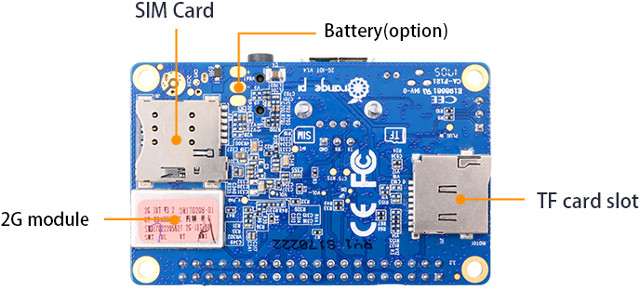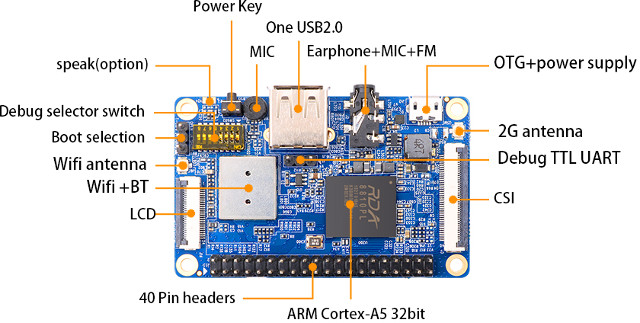Orange Pi 2G-IoT was unveiled at the start of the year as an ultra cheap ($10) Linux development board with 2G cellular connectivity. The board has just launched for $9.90 + shipping on Aliexpress.
Orange Pi 2G-IoT specifications have changed a little since the initial announced as WiFi is confirmed to be supported:
- SoC – RDA Micro 8810PL ARM Cortex A5 processor @ up to 1.0 GHz with 2Gbit (256 MB) on-chip LPDDR2 RAM, 4Gbit (512 MB) on-chip SLC NAND flash , 256KB L2 cache, Vivante GC860 3D GPU, and GSM/GPRS/EDGE Modem (Download datasheet)
- External Storage – micro SD slot
- Display I/F – LCD connector up to qHD resolution
- Video – Decoding up to 1080p30, encoding up to 1080p30 H.264
- Audio I/F – 3.5mm audio +FM jack, built-in microphone?
- Connectivity – WiFi 802.11 b/g/n + Bluetooth 2.1/EDR module (RDA5991), and 2G GSM/GPRS/EDGE module with SIM card slot
- Camera – MIPI CSI-2 connector for camera sensor up to 2MP
- USB – 1x USB host port, 1x micro USB OTG port
- Expansion – 40-pin GPIO header with SPI, I2C, GPIOs, etc…
- Debugging – 3x pin UART for serial console
- Misc – 8 selection jumpers, power button, boot selection header
- Power Supply – 5V via micro USB port; optional battery
- Dimensions – 68 x 42 mm
- Certifications – CE and FCC (if we can believe the markings on the PCB silkscreen)
 Linaro showcased Ubuntu on the similar Orange Pi i96 board at Linaro Connect Budapest 2017 last month, but I have not been able to find an image, nor source code yet. Needless to say, beginners better wait before buying this board, as everything is new, and software support is unclear at this stage. You’ll also have to check 2G sunset status in your countries, as some have stopped supporting 2G already, while others plan on keeping 2G networks for many more years.
Linaro showcased Ubuntu on the similar Orange Pi i96 board at Linaro Connect Budapest 2017 last month, but I have not been able to find an image, nor source code yet. Needless to say, beginners better wait before buying this board, as everything is new, and software support is unclear at this stage. You’ll also have to check 2G sunset status in your countries, as some have stopped supporting 2G already, while others plan on keeping 2G networks for many more years.
Thanks to OvCa77 for the tip.

Jean-Luc started CNX Software in 2010 as a part-time endeavor, before quitting his job as a software engineering manager, and starting to write daily news, and reviews full time later in 2011.
Support CNX Software! Donate via cryptocurrencies, become a Patron on Patreon, or purchase goods on Amazon or Aliexpress





